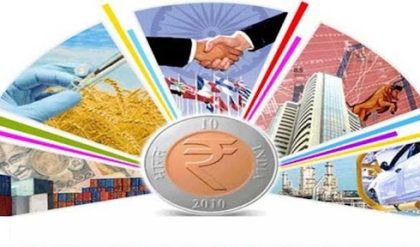Since independence India has been a ‘Mixed Economy’. India’s large public sectors were responsible for rendering the country a ‘mixed economy’ feature. Indian economy is basically based in the contribution of service sector (currently provides 60% share of GDP) and near about 53% of its population is dependent on the Agriculture. As soon as the time is passing, the share of Agriculture is decreasing and share of service sector is increasing. Currently India is called a developing economy of the world.
Features of Indian Economy
1. Since independence India has been a ‘mixed economy’. India’s large public sectors were responsible for providing employment and revenue to the economy.
2. India’s share in global exports and imports increased from 0.7% and 0.8% respectively in 2000 to 1.7% and 2.5% in 2012 as per the WTO estimates.
3. Indian economy overview was highly inspired by Soviet Union’s practices post-independence. It had been recording growth rate not greater than five jumped till 1980s. This stagnant growth was termed by many economists as ‘Hindu Growth Rate’.
4. In 1992, the country ushered into liberalization regime. Thereafter, the economy started scaling upward. This new trend in growth was called ‘New Hindu Growth Rate’.
5. India’s diverse economy encompasses traditional village farming, modern agriculture, handicrafts, a wide range of modern industries and a multitude of services.
6. Services are the major source of economic growth, accounting for more than half of India’s output with less than one third of its labour force.
Current Analysis
1. The current GDP factor cost is (at 2004-05 prices) Rs. 5748564 cr (2013-14)
2. Per capita Income (at current prices) Rs. 74920 (2013-14)
3. Gross domestic saving rate (at current market price as % of GDP) for 2-11-12 is 30.8%
4. Tertiary sector contributes 56% of GDP (2012-13).
5. Total food grain production is 265 million tone (2013-14).
6. India’s share in world export is 1.8% of total trade.
7. India’s share in total world import is 2.5%.
8. Total size of Indian population is 1.26 bn (2014).
9. Beating America and China, India saw the highest FDI inflow for new projects among all nations in the first half of calendar 2015. To boot, India attracted $31 billion against $12 billion in the first half of last year in capital expenditure (Capex) from foreign companies, while China and the US attracted $28 billion and $27 billion, respectively, in the same period.
10. Total size of foreign exchange reserve of India is $ 330 bn in 2015.
11. Exports of top five sectors — engineering, petroleum, gems and jewelery, textiles and pharmaceuticals – fell by about 25% to $13.33 billion in August 2015 due to global demand slowdown. These five sectors accounted for about 65% of the country’s total merchandise exports in 2014-15. In August last year, exports of these sectors stood at $17.79 billion.
Poverty Estimation:
i. The Rangarajan panel’s recommendation (those who spends Rs 32 in a day in rural areas and Rs 47 in towns and cities should not be considered poor,), results in an increase in the below poverty line population, which is estimated at 363 million in 2011-12, compared to the 270 million estimate based on the Tendulkar formula — an increase of almost 35%.
ii. This means 29.5% of the India population lives below the poverty line as defined by the Rangarajan committee, as against 21.9% according to Tendulkar. For 2009-10, Rangarajan has estimated that the share of BPL group in total population was 38.2%, translating into a decline in poverty ratio by 8.7 percentage points over a two-year period.
Indian economy is a mixed economy (combination of public and private sector). Currently India is considered as one of the most developing economy of the world because of its nature: part of agriculture in total GDP is decreasing, part of service sector is increasing or the contribution of tertiary sector is increasing in the GDP on year to year basis.






Comments are closed.